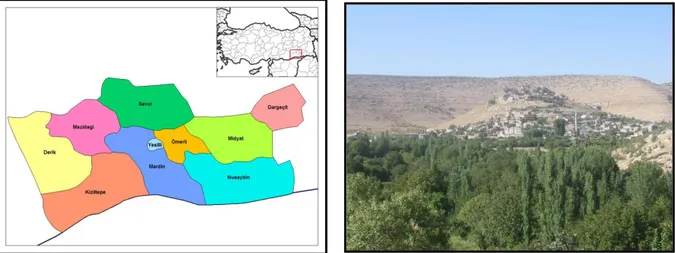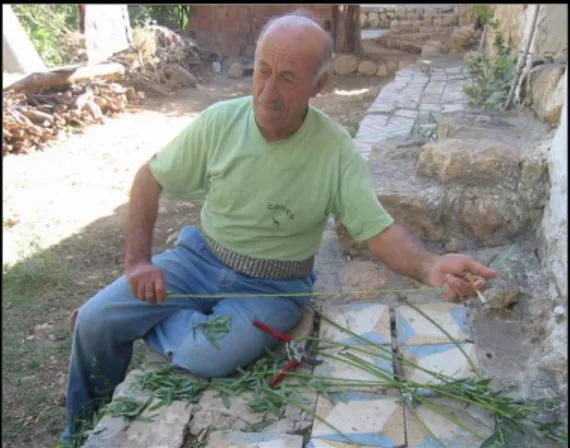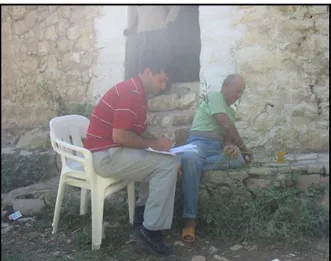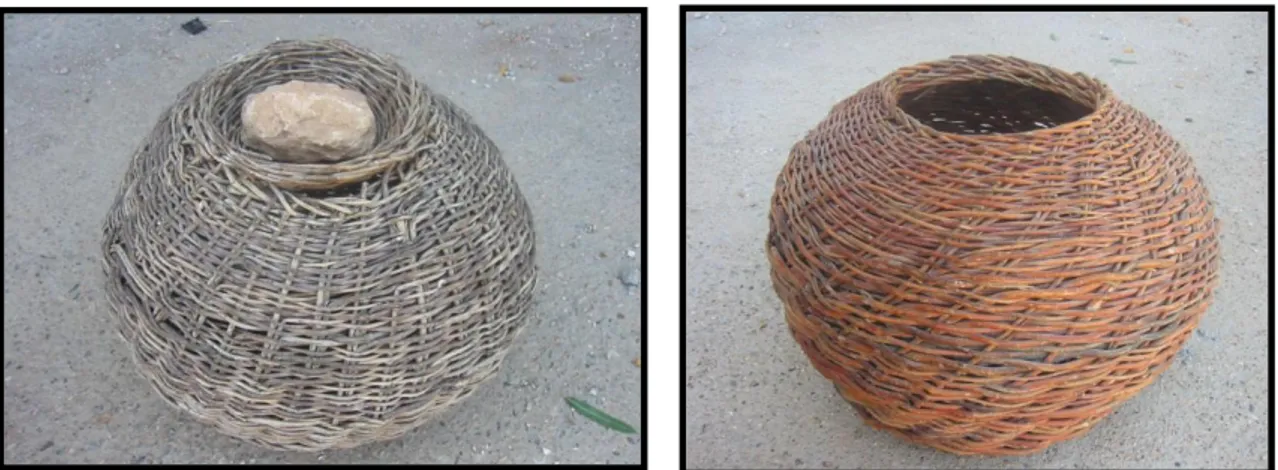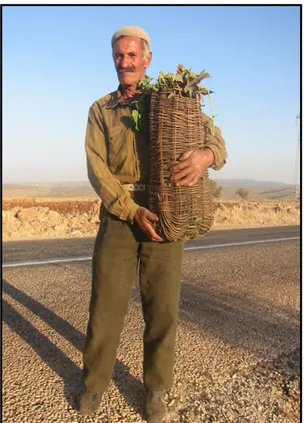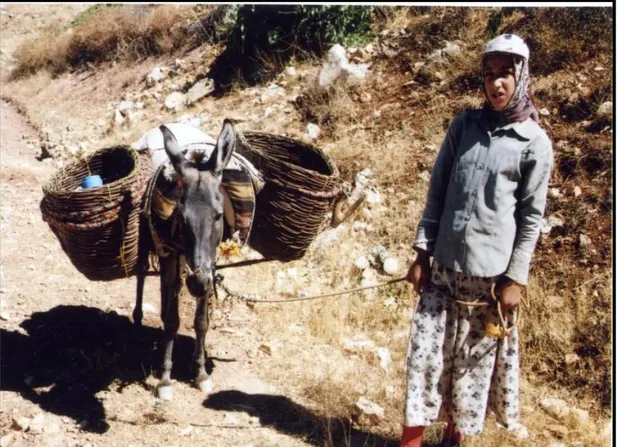21
An Ethnobotanical Investigation on The Baskets of Mardin, South East Anatolia
Hasan AKAN*,1
1Harran University, Arts & Science Faculty, Biology Department, Osmanbey Campus, 63300, Şanlıurfa.
ABSTRACT
In this study, it is explored how woody plants used in making handicraft of baskets in Midyat, Nusaybin, Akarsu, Kızıltepe provinces of Mardin, and how they are processed. In this area, six woody taxa is recorded (Salix viminalis L., Populus nigra L. subsp. nigra, Punica
granatum L., Celtis australis L., Cornus sanguineae L. subsp. australis (C.A.Meyer) Jav and Anagyris foetida L.) in basket production. The local names of the baskets determined in this
province, how these trees are processed, scientific and local names of these trees, where they are obtained, and archives of the photographs taken during this study are given.
Key Words: Ethnobotanic, Baskets, Handicraft, Mardin
Mardin (Güneydoğu Anadolu Bölgesi) Zembilleri Üzerine Etnobotanik Bir Araştırma
ÖZET
Bu çalışmada, Mardin’in ilçeleri olan Midyat, Nusaybin, Akarsu ve Kızıltepe’de sepetçilik el sanatında odunsu bitkilerden sepetlerin nasıl yapıldığı ve işlendiği araştırılmıştır. Bu bölgede 6 bitki türünün sepet yapımında kullanıldığı tespit edilmiştir. Bunlar; Salix viminalis L.,
Populus nigra L. subsp. nigra, Punica granatum L., Celtis australis L., Cornus sanguineae L.
subsp. australis (C.A.Meyer) Jav ve Anagyris foetida L.’dır. Bölgede, sepetlerin yöresel isimleri, ağaçların nasıl işlendiği, bitkilerin bilimsel ve yöresel isimleri, nereden temin edildikleri araştırılmış ve çalışma boyunca çekilen fotoğraflar arşivlenmiştir.
Anahtar Kelimeler: Etnobotanik, Sepetler, El Sanatları, Mardin
* Corresponding Author/ Yazışmalardan Sorumlu Yazar: Hasan AKAN
Harran University, Arts & Science Faculty, Biology Department, Osmanbey Campus, 63300, Şanlıurfa, Turkey. E-mail: hakan@harran.edu.tr
22 INTRODUCTION
Ethnobotanical investigations are important data for transportation of cultural heritage for future generations.The majority of Turkey, has not been discovered for the ethnobotanical aspect. Mardin is also one of the area that should be studied for ethnobotanical research.
The province of Mardin is located in Southeastern Anatolia lying between eastern longitudes 39 56° - 42 54° and northern latitudes 36 55° - 38 51°. The city itself is located on the southern slopes of a hill looking down to the Mesopotamian plains and is on the railway and highway routes connecting Turkey to Syria and Iraq. The total surface area of the province is 8.891 km2 and the city center is at 1.080 meters from the sea level. The province is surrounded by the provinces of Şırnak and Siirt to the east, Şanlıurfa to the west, Diyarbakır and Batman to the north, and Syria to the south (Figure 1) .High mountain ranges surrounding Mardin in the north influence the climate of the province. High pressure in winter makes this season rather cold. As such the province display the typical features of continental climate where summers are quite hot. Nevertheless the possibility of cotton, hazel nuts and olive culture in the districts of Derik, Nusaybin and Savur points out to the existence of a micro climatic area. According to meteorological data, Mardin has the highest precipitation in March with 115.8 m3 and the highest temperature of 42.5º C in July. The lowest temperature is measured in February (-2.6º C).
Mardin has a very rich past in several handicrafts including the basketry. Baskets that are used in this province show a great diversity. The region has very important of grape production and the most of the baskets have been using for carrying the grapes from vineyards and orchads. Handicraft of baskets in Mardin, is popular among some towns such as Midyat, Nusaybin, Akarsu (Figure 2) and Kızıltepe provinces.
Figure 1: The map of Mardin center Figure 2: General view of Akarsu town, the for the basketry
In the research area, ethnobotanical study related with the basketry has not been carried out up to date. However, some studies related on medicinal and aromatic plants are carried out by
23
Nahya (1983), Yağmur et al. (1991), Baytop (1997, 1999), Ertuğ (1999), Aksoy et al. (1988), Özel (1999), Anonymous (1999, 2001), Akgül (2008), Aslan et al. (2011), Sadıkoğlu (2012).
MATERIALS AND METHODS
This study have been carried out by consulting to artisians of basketry in Mardin in between the years of 2003 and 2005. The craftsmen have been interviewed directly and the information we obtained have been saved in “Mardin Ethnobotanic Data Base”. The original tree of this material, the regional names of baskets and the places to obtain the raw material have been determined. Furthermore, the photos of baskets have been taken and numbered in order to file. The “Flora of Turkey and the East Aegean Islands” (Davis, 1965-1985; Davis et al., 1988) was used to identify the plant samples.
The widespread name of plant is given according to Baytop (1997, 1999). The plant samples collected from the region are kept in the herbarium of Harran University, Şanlıurfa.
With the interviews, it is determined the local names, the using purpose, using manner, and using part of plant species. The following details are given for each basket: local names, the using purpose of object, using manner, location and the name of material with local and scientific names.
FINDINGS
Mardin has a very rich past in several handicrafts including the basketry. Baskets that are used in this province show a great diversity. These baskets had a rather important place in carrying fruits and vegetables from vineyards and orchards, in preserving the meat, meals and milk products while there were no refrigerators, in catching fishes, in gathering the small stones, and are used especially in carrying grapes.
The baskets are called in various names such as “Zembil, Salık, Denik, Mekep, Tebek, Cambak, Ka’tuf, Şibrik, and Gerzel” in this region, according to their shapes and functions. The artisans of basketry is known as “Zembilci, Zembilkar or Zembilfiroş” in the region.
Figure 3: The artisan of basket, known as Zembilci, in Akarsu, Mardin, 2004.
Figure 4: The artisan of basket practising the base of Zembil, Akarsu, Mardin, 2004.
24
Figure 5: H. Akan during his visiting, with the artisan of basket in Akarsu, Mardin, 2004.
Figure 6: Zembil, Akarsu, 2004.Generally for carrying vegetables and crops, and for storage of fruits. The material is Salix viminalis, called “hos” or “huis”.
Figure 9:Zembil, daily market, in Midyat, 2004. Figure 7:Zembil, Akarsu, 2004. The material is Anagyris foetida, called “Şırtık”.
Figure 10:Zembil, in Akarsu using for the storage of wheat.
Figure 8:Zembil, Nusaybin, 2004. It is made from Anagyris foetida, called “Şırtık”.
25
Figure 12:Tebek, Şıbrik l, in Akarsu using for the storage of bread and fruits. It is made from Populus nigra or Salix viminalis
Figure 14: Salkegenim, in Çaldere using for the storage of wheat.
Figure 11: Zembil, in Akarsu using for the carrying of wheat. It is made from Populus nigra, known as “Sipindar”.
Figure 13: Tebek, Şıbrik l, in Akarsu using for the storage of bread or covering the dairy products
26
Figure 20: Denik, kar’i, in Akarsu using for the storage of dried vegetables and meat.
Figure 17:Tebek, in Akarsu using for the storage of the dried winter vegetables.
Figure 18:Tebek, in Akarsu using for the storage of dried materials or meals covering
Figure 19:Denik, kar’i, in Akarsu using for the storage of wheat.
Figure 15:Salkegenim, in Çaldere using for the storage of bread or fruits.
Figure 16: Sifri, in Çaldere using for the storage of wheat.
27 Figure 21: Salik, made of from Cornus
sanguineae, Nusaybin, 2004.Mainly for carrying grape
Figure 23: A person with Salik, made from Celtis australis, in Midyat, 2004.
Figure 22: A farmer with Salik, Nusaybin, 2004.
Figure 24: Ka’tuf (Salik), Midyat, 2004. Generally for carrying grape
28 Figure 27: Salık, in Midyat using for used for carrying fruits vegetables and eggs.
Figure 25: Aleka (Salık), in Akarsu, Nusaybin, 2004. It is made from Salix viminalis, Hos. It is used for carrying fruits.
Figure 26:Salik or Aleka, in Akarsu, Nusaybin, 2004. It is made from Punica granata. used for carrying fruits.
Figure 28: Salık, in Midyat using for used for carrying fruits vegetables and eggs.
Figure 29: Ka’tuf (Salik), Nusaybin, 2004.Generally for carrying grape and picnic materials.
Figure 30: Salık, in daily market of Midyat, grapes are for selling within the Salik
29
Table 1: The Local names of baskets in Mardin with their materials and functions Local names of
baskets
Plant names Local names
of plant
Function Figure no
Salik(Ka’tuf) Celtis australis Tegev, teav Carrying grapes,other fruit, vegetables, picnic materials and eggs.
21, 22, 23, 24,27, 28, 29
Zembil Salix viminalis, Anagyris foetida hos or huis; Şırtık
Generally for carrying vegetables, crops, and for storage of fruits
6, 7, 8, 9, 10, 11
Tebek (Şibrik) Anagyris foetida, Populus nigra Şırtık, Spinder storage of dried materials or covering meals, bread or covering the dairy roducts
12, 13, 17, 18
Aleka( Salik) Punica granata Hinar, nar carrying fruits 25, 26
Denik (Kar’i) Salix viminalis hos or huis storage of wheat 19, 20
Cembi (Cambak)
Salix viminalis hos or huis carrying the grapes or other fruits from the fields
31
Sıfri Triticum vulgare genim, zet,
buğday Storage for bread 16
Salıka genım Triticum vulgare genim, zet,
buğday
storage of bread or fruits. 14, 15 Figure 31: Cembi, Cambak, in Midyat, using for carrying the grapes or other fruits from the fields.
30 DISCUSSION
Basketry is one of the handicraft occupation in the past in Mardin. The profession today is moving towards extinction. The main reason for this situation is due to the fact that the opportunities offered by developing technology. Basketry in the Mardin region is also one of the occupation among local people and disappearing day by day.
ACKNOWLEDGEMENT
I would like to thank to the citiziens of Mardin for sharing their knowledge, to Dr. Füsun Ertuğ and to Dr. Dario Novellino for useful discussion and to TUBİTAK (TBAG-Ç. Sek/22) for financial support.
REFERENCES
Akgül, S., Midyat (Mardin) Civarında Etnobotanik, Yüksek Lisans Tezi, Ege Üniversitesi Fen Bilimleri Enstitüsü, Bornova-İzmir, (2008).
Aksoy, C., Yücecan, S., Çiftçi N., Tayfur, M., Akgün, B., Taşçı, N., 1988. Kanser Hastalığında Tedavi Amacıyla Kullanılan Yöresel Bitkiler, Beslenme ve Diyet Dergisi, 17: 111-120.
Anonymus, 1999. Türkçe bitki adları sözlüğü. Türk Dil Kurumu Yayınları, Türk Kültür Dil ve Tarih Yüksek Kurumu, Türk Dil Kurumu Yayınları 578, Ankara.
Anonymous, 2001. GAP Yöresindeki Endemik ve Tıbbi Bitkiler, Türkiye Çevre Vakfı Yayını, No: 143, Önder Matbaa, Ankara.
Aslan M, Akan H, Balos M.M (2011) Şanlıurfa'da Bazı Odunsu Bitkilerin Etnobotaniği Üzerine Bir Araştırma. Ot Sistematik Botanik Dergisi Cilt:18, Sayı:1 Sayfa 117-137. Baytop, T., 1997. Türkiye’de bitkilerle tedavi:geçmişte ve bugün. İstanbul Üniversitesi
Yayınları.
Baytop, T., 1999. Türkçe bitki adları sözlüğü. Türk Dil Kurumu Yayınları, Türk Kültür Dil ve Tarih Yüksek Kurumu, Türk Dil Kurumu Yayınları 578, Ankara.
Davis PH (ed.) (1965-1985). Flora of Turkey and the East Aegean Islands. vol. 1-9. Edinburgh: Edinburgh University Press.
Davis PH, Mill RR, Tan K (eds) (1988). Flora of Turkey and the East Aegean Islands (Supplement) vol. 10. Edinburgh Uni. Press.
Ertuğ, F. 1999. Plants Used in Domestic Handicrafts in Central Turkey, Ot Sistematik Bot Dergisi, 6 (2): 57-68.
Nahya, Z., 1983. Urfa’da Doğum Gelenek ve Görenekleri, Türk Folklor Araştırmaları, 73-80. Özel, H., 1999. Güneydoğu Anadolu Bölgesi Tıbbi ve Aromatik Bitkileri, GAP I. Tarım
Kongresi, 869-876, 26-28 Mayıs, Şanlıurfa.
Sadıkoğlu N (2012). Midyat İlçesinde (Mardin) geleneksel halk ilacı olarak kullanılan bitkiler, 20. Bitkisel İlaç hammaddeleri (BİHAT) toplantısı, 10-13 Ekim 2012, Antalya.
Yağmur, C., Yücecan, S., Tayfur, M., Akgün, B., Taşçı, N., 1991. Sindirim sistemi rahatsızlıklarında kullanılan yöresel bitkiler, Çukurova Üniversitesi Ziraat Fakültesi
